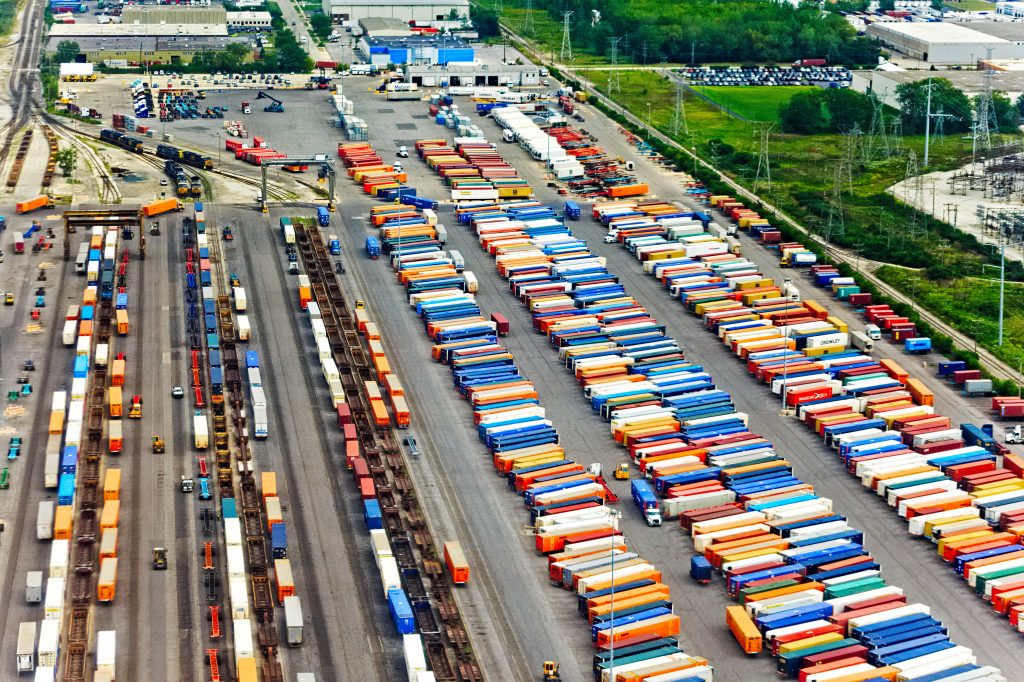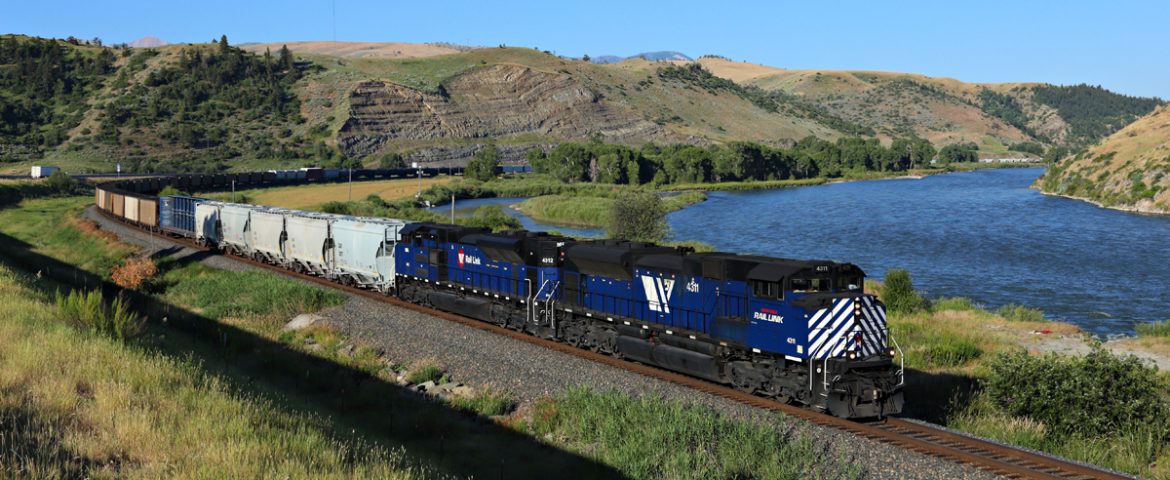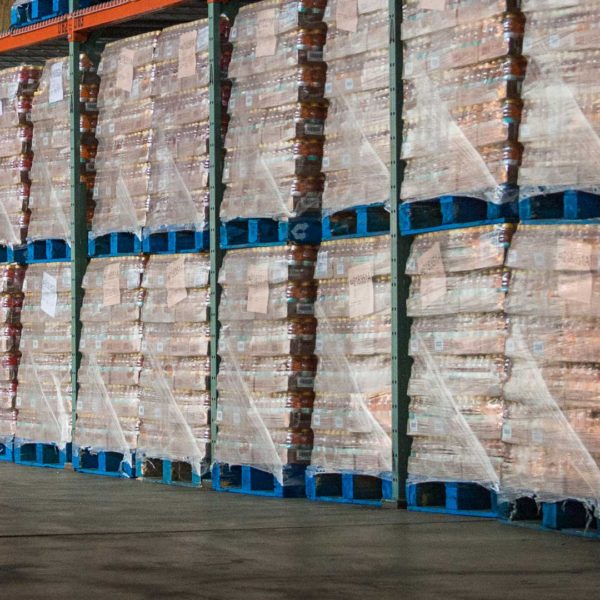Freight trains can carry one ton of freight nearly 500 miles while only using 1 gallon of diesel fuel. Compared with over the road trucks, moving freight by rail reduces greenhouse gas emissions by an average of 75% while also reducing road congestion and roadway wear and tear.
The inherent efficiency of rail transportation, particularly for heavy bulk commodities such as grain, ethanol, plastic pellets and aggregates leads it to being a near dominant form of transportation for long haul bulk freight. One freight train can haul 200 cars or more, each with 100 tons of freight. It would take nearly 800 trucks to move the same amount of cargo.
The steel on steel friction of railroad wheels riding on steel rails is much lower compared with the rubber on road friction that trucks have to contend with. Also railway locomotives benefit from the physical size of their engines, modern railway road locomotives are commonly 4000-4500 horsepower, developed from one 16 cylinder diesel engine, with less thought given to weight. This means that horsepower per horsepower, railway locomotives’ diesel engines are much more efficient than truck diesel engines. This is a similar concept to how small gasoline generators are much less efficient than large commercial power plants per kilowatt generated. Railway locomotives are evolving to be more energy efficient and many now conform to EPA Tier4B requirements, have automatic engine shutdown and computer controlled engine management to monitor throttle settings. While not always the case, many times trains are not required to speed up and slow down as much as trucks which help railway locomotives operate in more of a steady state at more constant RPMs, which also minimizes fuel wastage.
While railroads are no longer the dominant form of land transportation, with over the road trucks moving more total volume and total dollar value of freight, railroads are still a strategically important form of transportation that transports around 40% of domestic ton miles and 15% of the total value of goods moved in the US. Railroads also represent a 10-25% cost savings when compared with trucking costs on many routes which makes them a preferred choice on applicable longer routes and for firms moving bulk commodities.

Emission standards will continue to tighten with more supply chains putting a greater emphasis on “green supply chains”, which focus on sustainability throughout all levels of a supply chain. Freight volumes are forecasted to rise 37% over today’s total volumes according to the DOT. By increasing the amount of freight on trains, the number of trucks that must travel on our nation’s highways is reduced. This not only increases road safety, but also decreases roadway wear and tear and thus road maintenance costs. Many states and cities are investing large amounts of money to help convert freight from truck to rail because of such reasons. The state of Georgia built an inland port North of Atlanta, which allows freight coming from it’s Georgia Port Authority to bypass the roads of Atlanta.
These pressures will likely push a small increase in market share to railroads from trucks over time. Converting just 5% of trucking freight to rail will eliminate 9 million tons of greenhouse gases.

Supply chains have always relied on a varied system of transportation to move different types of cargo globally. It’s easy to take railroads for granted now, but before the completion of the interstate highway system and general rise of the automobile, railroads were “THE” method for moving people and things across the country. Prior to trains, horse and buggies were the main method of transportation, which drastically limited the amount and speed of overland transportation.
Railroads provided the critical link necessary to expand westward and helped transform the US into the industrial powerhouse it became. Cross country trips that required weeks or months now required a few days.
Over time supply chains adapted to rely more and more on trucks, which lend themselves better for short and mid length hauls, and for their usability to deliver freight on any route. While trains are more suited to long haul ( 800 miles or more) routes between major cities or from ports to major cities or distribution centers. Some larger manufacturing and warehousing facilities actually have railroad tracks that go directly into their factory which facilities using rail freight services. For shippers that wish to utilize rail services but don’t have a direct railroad track connection at their facility, they use intermodal transportation.

Intermodal transportation is the process of putting freight in containers, then using trucks to move the container to a rail yard or port ( known as first mile or drayage), then loading the container onto a train for the long haul portion of the trip. The containers are transloaded back onto a truck for its “final mile” portion of the trip to the final destination. Intermodal is a popular form of transportation for shippers that ship freight cross country or cross border in North America. While shipment times are generally a day or two longer than over the road trucks, intermodal represent a 10-25% cost savings which ads up dramatically for larger shippers. Many times containers are “double stacked” onto rail cars which allows one railcar to carry two containers. This process was developed in the late 70s on the Southern Pacific railroad and really started to take off in the 80s. Common intermodal shipment lanes include routes from port cities to large municipalities and cross country lanes such as Los Angeles to Atlanta, Los Angeles to Chicago, or Port of Norfolk to Chicago.

What’s also surprising about rail transportation is the sheer scale of the industry with total US railroad revenues totaling $70 Billion and $88 billion in wages. Private railroad investment into infrastructure totaled $30 Billion dollars in 2015 alone.
Railroads will continue to improve their efficiencies and invest in ever more modern locomotives to improve emissions and fuel consumption while remaining a backbone of American industrial strength. Next time you have to wait at a crossing for a train to go by, just be glad that cargo is on a train and not an additional 800 trucks competing with you for the road!
Recommended for further reading:
https://www.bts.gov/newsroom/2017-north-american-freight-numbers
https://www.aar.org/wp-content/uploads/2018/05/AAR-Overview-Americas-Freight-Railroads.pdf
https://www.bts.gov/archive/publications/special_reports_and_issue_briefs/special_report/2014_08
Featured Image Source: Flickr



